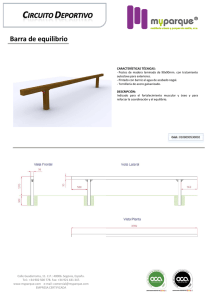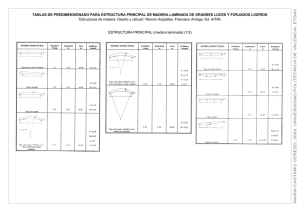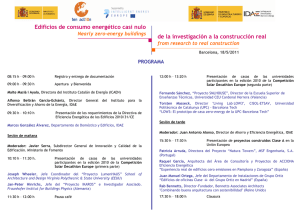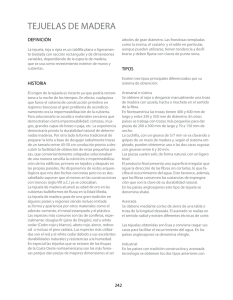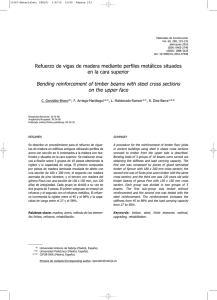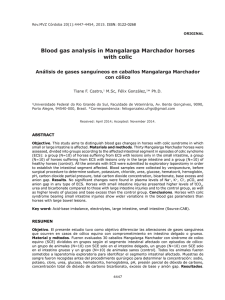Martin-Hurtado-Haras-Las-Camelias
Anuncio
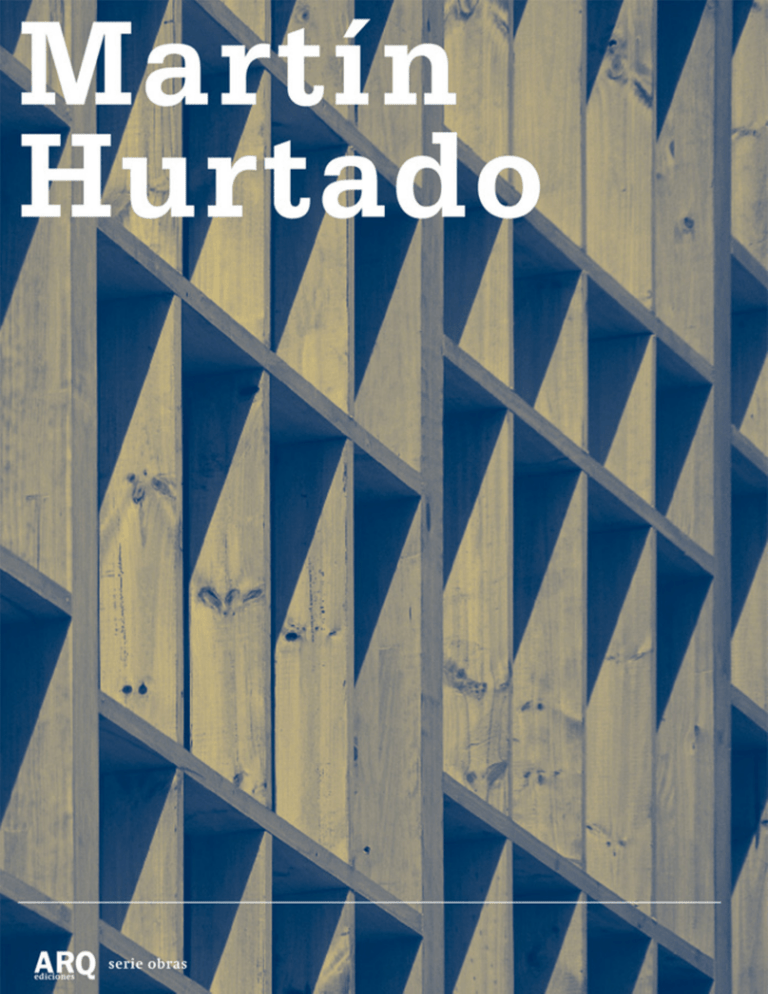
Haras Las Camelias Cliente Client Agrícola y Haras Las Camelias Ltda. ı Proyecto Project 2007 ı Construcción Construction 2008 ı Superficie terreno Site area 26 ha ı Superficie construida Built area 625,11 m2 ı Presupuesto Budget 11,85 uf/m2 Fotografía Photo Leonardo Finotti ı Arquitecto colaborador Collaborator Andrés Suárez Dibujo de planos Drawings Raimundo Arteaga, Sebastián Erazo, Iván Salas ı Renders Visualizations Martín Hurtado (croquis) Ingeniería Estructural Structure engineer Ingelam - Juan Acevedo ı Constructor Builder Constructora g h g S.A. 38 San Bernardo 2008 Cuatro construcciones de galpones muy precarias formaban el criadero original. Todas eran naves longitudinales con cubierta a dos aguas y. estaban dispuestas de forma paralela a uno de los límites del terreno. El resto del predio quedaba liberado para los potreros de pasto y las labores de crianza de caballos. Para el proyecto, que consistía en la ampliación de estos edificios, se reemplazó uno de los galpones existentes. Se mantuvo su ubicación y un cierto lenguaje mimético con el fin de consolidar la frágil armonía del conjunto. Se introdujo un sistema prefabricado en madera laminada con la intención de que en el futuro fuese el sistema de los próximos edificios. El programa se dividió en dos áreas: una maternidad para yeguas con dos pesebreras, un laboratorio y una farmacia; y una zona de oficinas con una sala de reunión para recibir a los posibles compradores de caballos. Entre ambas, se dispusieron extensas áreas cubiertas para que sirvieran de espacios intermedios de recorrido y permitieran estar “a la sombra”, tanto a los caballos como a los trabajadores. Esa coexistencia entre personas y caballos determinó la selección de los materiales, la disposición axial del programa y las medidas y tamaños de los recintos, combinando patrones de uso propios de estos animales, como una mayor altura libre de piso a cielo, los pavimentos de adoquines de goma y los paramentos resistentes a las pateaduras, con patrones de espacio propios de las construcciones rurales, como las galerías y los corredores techados. La neutralidad del nuevo edificio establece una relación fluida con el lugar y fortalece el vínculo con el “saber hacer” del oficio que levantó las construcciones anteriores, pero a la vez, da un salto adelante en cuanto a la técnica que los hizo posibles. Four very precarious buildings were part of the original farm. All consisted of gable roof longitudinal naves running parallel to one of the boundaries. The rest of the land was free for grass pastures and the work of a breeding farm. For the project, which consisted in the enlargement of these buildings, one of the existing stables was replaced. Its location and a certain mimetic language were preserved to consolidate the fragile harmony of the whole. A prefabricated system in laminated timber was introduced with the intention that this technique would be applied in the future to the next buildings. The program was divided into two areas: a two-stall birthing room for mares, a laboratory, a pharmacy and a zone for offices with a room to meet possible horse buyers. Between these, large covered areas serve as intermediate spaces for circulation and to shade horses and workers. This coexistence between people and horses determined the choice of materials, the axial disposition of the program and the measurements and sizes of the rooms, providing for the habits and needs of the horses, like greater free space from floor to ceiling, rubber cobblestone paving and surfaces which can withstand kicking, as also space distributions proper to rural constructions such as galleries and roofed corridors. The neutrality of the new building establishes a fluid relation with the place and strengthens the link between the “know how” of the manual trade which built the first constructions. Yet, at the same time, there's a leap forward regarding the technique which made the old buildings possible. Sistema constructivo estructura de madera laminada encolada y hormigón armado. Cerramientos muros de hormigón a la vista; machihembrado bruto 1"x 6" entre pilares de madera laminada, terminada con pintura impregnante alquid-acrílica al agua, negro humo; cristal simple de 4 mm en paños fijos, ventanas de guillotina y proyectantes. Cubierta tejuela asfáltica. Terminaciones interiores cielos de terciado y yeso cartón; pavimentos de piedra pizarra y adoquines de goma; tabiquerías de madera. Construction system structure of glued laminated timber and reinforced concrete. Enclosures exposed concrete wall, 1”x 6” tongue and groove rough joint between pillars of laminated timber, finished with water based alkydacrylic impregnating paint, black smoke color; single 4 mm glass in fixed panels, hung and projected windows. Roofing asphalt shingles. Interior finishes plasterboard and plywood ceilings; slate and rubber cobblestone flooring; wood partitions. 39 Camino vecinal 6 3 51 516 5.5 1 .00 0 Canal 3 7 00 5. 51 2 4 6 51 4.5 1 0 5 51 4.0 0 513 .50 1 513 .00 6 512 3 .50 0 2.0 51 .50 511 51 1. 00 50 0. 51 51 0. 50 00 9.5 1 Galpón existente Existing building 2 Área intervenida Intervention area 3Casa House 4Torre Tower 5Troya Paddock 6Bodega Warehouse 7Estacionamientos Parking area Planta emplazamiento Site Plan 1: 5.000 40 Canal 509.50 0 41 B B 3 2 1 1Oficina Office 2 Pista interior Inside track 3Maternidad Birthing room Planta Plan 1: 250 42 C C A A 43 -0.20 Elevación norte North Façade -0.20 ± 0.0 Elevación sur South Façade +6.50 -0.20 AA Cortes Sections 1: 250 44 + 6.50 ± 0.0 -0.24 -0.24 BB -0.20 + 6.50 ± 0.0 -0.20 + 6.50 ± 0.0 7 8 9 10 11 12 -0.20 Detalle corte – oficinas Section Detail – Offices 1: 100 +6.50 13 45 % 45 % +3.77 6 5 +3.40 4 3 2 ± 0.0 1 -0.20 -0.25 1 Perfil tubular 150 x 65 x 5 mm 2 Pilar doble 2”x 8” 3 Espaciador 65 x 185 mm 4 Diagonal 65 x 150 mm 5 Doble pletina 100 x 6 mm 6 Viga 65 x 280 mm 7 Costaneras 2”x 8” 8 Cadeneteado 2”x 4” 9 Terciado e= 12 mm 10Fieltro 11 Cubierta de tejuela asfáltica 12 Lana de vidrio, dos capas de 50 mm c/u 13 Vigas 65 x 210 mm, cada 61 cm 1 SHS section 150 x 65 x 5 mm 2 2”x 8” double wooden pillar 3 Spacer block 65 x 185 mm 4 Diagonal 65 x 150 mm 5 Double plate 100 x 6 mm 6 Beam 65 x 280 mm 7 2” x 8” girders 8 2” x 4” secondary wooden beams 9 Plywood t= 12 mm 10Felt 11 Asphalt tiles roofing 12 Fiberglass insulation, two layers of 50 mm each 13 Beams 65 x 210 mm, every 61 cm CC 45 46 2 3 90 120 229 339 4 1 Detalle corte AA AA Section Detail Revestimiento epóxico Tecle de cadena manual 800 kg Vigas 65 x 210 mm, cada 120 cm Lana de vidrio, dos capas de 50 mm c/u 1 2 3 4 1 2 3 4 Epoxy coating Hand chain hoist 800 kg Beams 65 x 210 mm, every 120 cm Fiberglass insulation, two layers of 50 mm each 2 1 120 2 120 120 120 120 120 4 3 120 120 120 120 120 115.8 115.3 120 1366 162.5 151 160 158 151 467 348 23 230.2 59.8 A 120 39.4 84 B 80.6 240 40 483.5 533.5 A 6.5 6.5 200 1% 115 35 1% 122 122 115.5 6.5 471.5 158 A 1% 1% 120 A 1% C 1% 122 6.5 115.5 200 6.5 122 115.5 110.2 471.5 6.5 113.5 6.5 6.5 113.5 467 113.5 6.5 113.5 6.5 113.5 6.5 113.5 6.5 113.5 6.5 113.5 6.5 113.5 6.5 348 113.5 40 6.5 113.5 6.519.8 1366 120 120 120 5 120 120 80 113.5 40 102 19 106 19 190 120 120 5 120 1 120 120 120 3 4 Detalle planta Plan Detail ACaballeriza Stables BFarmacia Pharmacy CBrete Weigh crate 1 Pie derecho 65 x 230 mm 2 Tecle de cadena manual para 800 kg 3 Ventana guillotina 4Diagonal 5 Canal de evacuación 1 Stud 65 x 230 mm 2 Hand chain hoist for 800 kg 3 Hung window 4Diagonal 5 Evacuation canal Maternidad Birthing Room 1: 100 47 48 49 Martín Hurtado Martín Hurtado
